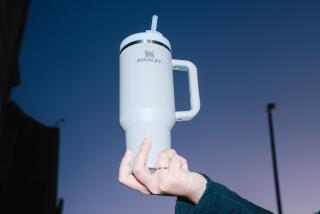Gatorade Has Competition On the Run
- Share via
CHICAGO — It crushes the competition on sidelines, finish lines and checkout lines. Its name is as synonymous with sports drinks as Kleenex is with tissues and Frisbee with flying discs.
Long the thirst-quencher of choice for jocks and other heavy sweaters, Gatorade has become a powerhouse product in supermarkets and convenience stores. It has only one real rival.
“The biggest enemy is tap water,” pronounced Robert S. Morrison, chief of Gatorade’s parent, Quaker Oats Co., during a recent interview.
Morrison wasn’t joking. Gatorade has effectively declared war on water.
The company has rolled out more flavors, multi-packs and new bottles and employed a special sales force to expand Gatorade distribution. Coming off strong debuts for its Gatorade Frost and Fierce brands the last two summers, it also has introduced a flavored “fitness water” called Propel, a lower-calorie Gatorade spinoff.
That aggressive strategy is projected to help pad Gatorade’s U.S. sales by two-thirds, or $1 billion, over the next five years. The beverage already commands 82% of the U.S. sports drink market and had 1999 global sales of $1.83 billion.
Quaker’s stated goal: Make Gatorade available everywhere that there’s water.
“When we’re done, tap water will be relegated to showers and washing dishes,” Susan Wellington, president of Quaker’s U.S. beverage division, boasted playfully to a group of analysts recently.
It may be quietly moving in on Coca-Cola and PepsiCo, too. Having conquered the sports drink arena, Gatorade has eased into the mainstream beverage market.
“It’s disguised as a sports beverage, so as not to anger Coke,” says analyst Nomi Ghez of Goldman, Sachs & Co. “But in reality, it’s a major entry in the general beverage industry. You see kids walking around drinking Gatorade--they’re not sweating.”
Quaker’s big push into Gatorade, now its No. 1 product with more than 40% of company sales, might surprise some who remember its disastrous acquisition of Snapple. That drink never caught on beyond its core markets on the coasts, costing Quaker $1.4 billion by the time it dumped it in 1997.
Gatorade’s deeper roots convinced Quaker that consumers could guzzle much more of the sports beverage.
It was developed by University of Florida researchers to help prevent dehydration. Tested on the football team starting in 1965, it was credited with helping to give the Gators a reputation as the “second-half team” for outplaying their opponents in the final half.
Stokely-Van Camp bought the rights and Gatorade soon went near-nationwide. But when Quaker acquired it in 1983, there were still only two flavors and modest sales of $97 million.
How it became a dominant consumer brand is described by experts as nothing less than a marketing coup.
Early on, Quaker took steps to enhance Gatorade’s reputation as certifiably good for performance, founding the Gatorade Sports Science Institute. By the early ‘90s it had locked in most major pro sports leagues to long-term contracts, providing immeasurable visibility.
Michael Jordan was signed to a 10-year promotional deal in 1992, giving Gatorade priceless exposure. Budding superstars--including soccer player Mia Hamm, quarterback Peyton Manning and NBA star Vince Carter--are providing newer marketing clout.
And more than a dozen flavors have been added.
“It’s become a mainstream new-economy product,” says analyst John McMillin of Prudential Securities. “They’ve succeeded in expanding beyond the male athlete stereotype to reach less serious athletes, females, kids as young as 5.”
Despite marketing costs, sales and profit keep surging. Profit topped $250 million last year, Gatorade’s fastest-growth year ever with a 12% rise in U.S. sales.
PowerAde, made by Coca-Cola, and PepsiCo’s AllSport are dwarfs by comparison.
Coca-Cola spokesman Scott Williamson said Gatorade is formidable but has the advantage of “a decades-long head start” over 7-year-old PowerAde. Pepsi spokesman Bart Casabona, meanwhile, called its AllSport line “small but profitable.”
The global frontier remains largely unconquered for Gatorade, although it’s sold in 47 countries. Weak results in Europe, except for Italy, have slowed its advance.
The prime targets are closer to home. Morrison taps his forefinger on a pie chart showing Gatorade with only 7% of what he says is a $10-billion U.S. “active thirst” market -- beverages consumed by people when they’re hot and sweaty. The biggest share, 35%, is held by tap water.
“We’re not against water--it just has its place,” he says. “We think it’s good for irrigation and cooking.”
More to Read
Inside the business of entertainment
The Wide Shot brings you news, analysis and insights on everything from streaming wars to production — and what it all means for the future.
You may occasionally receive promotional content from the Los Angeles Times.










